A systematic storage space for shoes is just as important as a wardrobe for clothes. Nobody stores shirts and dresses in boxes, shoes also do not like this attitude. Small shoe racks are designed to hold seasonal shoes, and cabinets are designed to store them throughout the year.

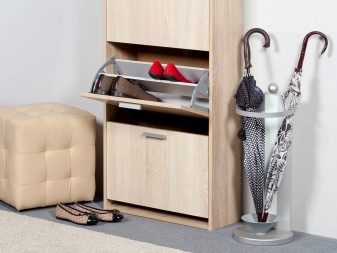
Features
The modern look of shoe racks has long departed from the image of several lattice shelves in the hallway. Today it can be a beautiful freestanding piece of furniture or be part of a headset. There are other options, for example, combining a shoe rack with a bench, hanger or mirror.

The advantages of this design are many. Spectacular items can become a real decoration of the hallway. If there is enough space in the corridor to install a large cabinet, shoes for all seasons can easily be assembled in it. This makes it possible to systematize storage. Shoes no longer need to be searched throughout the apartment, and the hallway takes on a well-groomed, neat appearance.
The advantage of shoe racks lies in their easy accessibility - each item takes its place on the shelf and is in the field of view of the owner.

Halls in houses and apartments have a different area and configuration. Studying consumer demand, the industry produces shoe racks of any size that can occupy a free wall, niche or corner. For particularly cramped conditions invented slim system depth not more than 30 cm. Shoes are stored on it compactly, installed at an acute angle.

Types of designs
Today, a shoe rack can be chosen for every taste and stylized to any interior.Furniture designers come up with designs with increased functionality and accessibility (rotating), or ergonomic, fighting for every centimeter in the hallway ("slim"). There are many storage options, and in order to make a choice, we will consider each of them.

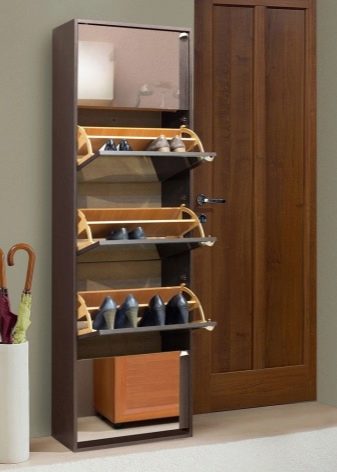
Open
These are the most popular models, not weighed down by doors. They have easy access and good visibility. When open, the shoes are easily ventilated and do not preserve an unpleasant odor. But such a storage system also has its weaknesses - old shoes put on display or in a hurry, spaced shoes spoil the aesthetic appearance of the room. Besides, shoe racks without doors easily collect dust and are suitable only for everyday use.
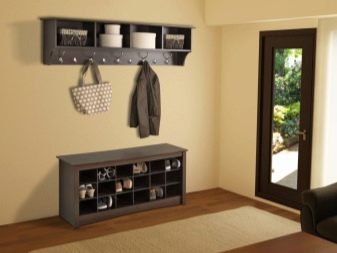



In fact, half of the different types of furniture intended for storing shoes belong to open structures.
Closed
The second half of the shoe racks can be considered closed products. These include cabinets, cabinets, that is, structures equipped with doors. Unlike open shelves, they don’t collect dust, you can put unsightly shoes in them or put them in haste, and get out later - closed shelves will bear it. The advantage of hidden structures is highly appreciated in families with pets - household shoes are not threatened by bites and scratches of your favorite pets.
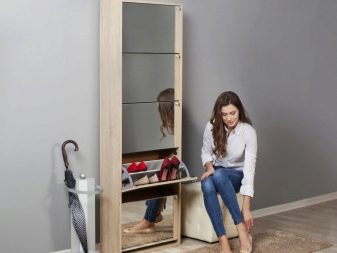
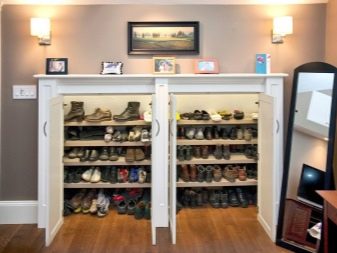


There is only one drawback of covered shoe racks - poor ventilation. In such conditions, bacteria and fungi develop, an unpleasant odor stagnates.
Racks
They should pay attention to large families, where there are a lot of shoes, since racks belong to one of the most capacious models. They can be open or closed, have a size of 1.5 meters and under the ceiling. Shoes are laid at an angle on shelves that rotate with the structure. By cons include their weak stability and impressive volume.

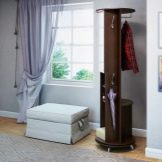


Slim
This design can be considered a good solution for small halls. Shoes are mounted on extendable or conventional shelves at an angle of 30-90 degrees. The depth of the shoe system "slim" is from 20 to 30 centimeters. The design only slightly stands out against the wall. Its disadvantages include not very convenient use and poor stability. Despite the fact that “slim” is divided into wall and floor, fix both options to the wall.

Wardrobe "Bona"
This design applies to closed storage systems. The cabinet body is assembled from particle boards or wood, and the inside is filled with metal grating shelves and drawers. In such storage conditions, the shoes seem to freeze in the air and are better ventilated.

With seats
Designs can be open and closed, that is, the seats are mounted on a pedestal with doors or a low durable shelf. They are released in the form of a bench (hard version), or a small sofa with a soft seat. On sale you can find chests for shoes, the cover of which has a seat. The model allows you to remove shoes while sitting, which is very convenient, especially in a small hallway, where it is difficult to turn around and use a chair.




Shoe cabinet
A simple product, which is a closed cabinet with several shelves. The design has compartments for small items for shoe care. You can put a bag on the stand, put an umbrella or a phone - this is convenient. But if the number of items increases, the furniture will look cluttered. In addition, the design is quite dimensional and poorly ventilated. A small number of shelves speaks of its everyday purpose, which makes it possible to ventilate shoes during hiking on the street.




Corner
They are not very convenient for building shoes on shelves, but ergonomically occupy an empty corner, belong to compact and roomy models.


Shoe rack
The multifunctional design looks like a pedestal turning into a stand with hooks for outerwear. Sometimes a seat is mounted on a pedestal.In addition to shoes and hangers, the model may include a mirror, a shelf for hats and a stand for umbrellas. The product can be straight or angular.

Shoe dryer
This is a closed type of furniture, equipped with ultraviolet lamps that dry and disinfect shoes, eliminating their unpleasant odor. Unfortunately, not every model can be dried in this way, you should read the instructions. Tumble dryers are especially good for damp regions in which the shoes do not have time to dry out on their own until the morning.

Galoshnitsa
The simplest version of shoe racks, consisting of two open shelves. Shoes are placed in a horizontal position. Small compact models are for everyday use.
The listed shoe racks are far from all types produced by the furniture industry. For shoes, you can also use sliding wardrobes stuffed with shelves for shoes. Suitcases, boxes, boxes laid on shelves in a large hallway also serve as original places for storing shoes, although they are inconvenient options.


Materials of manufacture
A variety of materials from which shoe racks are made, makes it possible to pick them up to existing furniture in the hallway. The industry produces shoe boxes from the following materials.
Wood
Shelves made of apple, cherry, oak, cedar, alder look expensive and presentable, especially if decorated with openwork carvings. Wood products are classics, they are good for interiors with an ecological bias. Despite the fact that the wood is treated with antifungal impregnations and coated with moisture-resistant paints, shoes in a similar design are better to put dried.
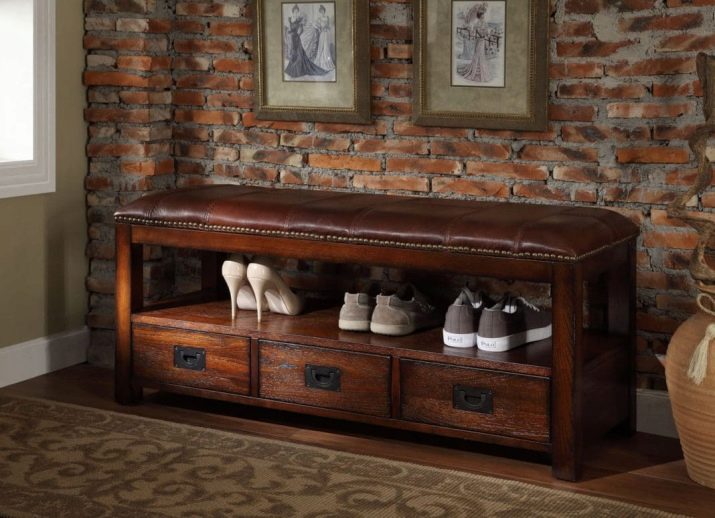
Particleboard and MDF
Particleboard is by far the most used and budget material. It successfully replaces wood and significantly reduces the cost of products. It is better to give preference to furniture made of MDF, it can be decorated with embossing and it does not have toxic adhesive impregnations, which are often used to create chipboards. Chipboards from chipboard and MDF do not like moisture, so they should be filled with dry and clean shoes.
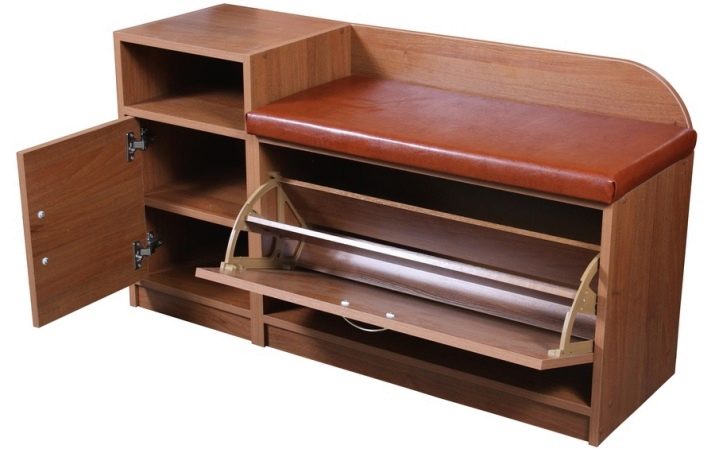
Metal
Metal products are processed anti-corrosion compounds such shoe-makers are not afraid of wet shoes. Down under the open shelves they put a pallet where moisture and dirt from shoes get. This is a durable material, it can be used for products with seats, as they can withstand any weight of a person. Shoe boxes come in stainless steel, chromed metal, but iron forged products, which are often made in combination with a hanger, look especially impressive.
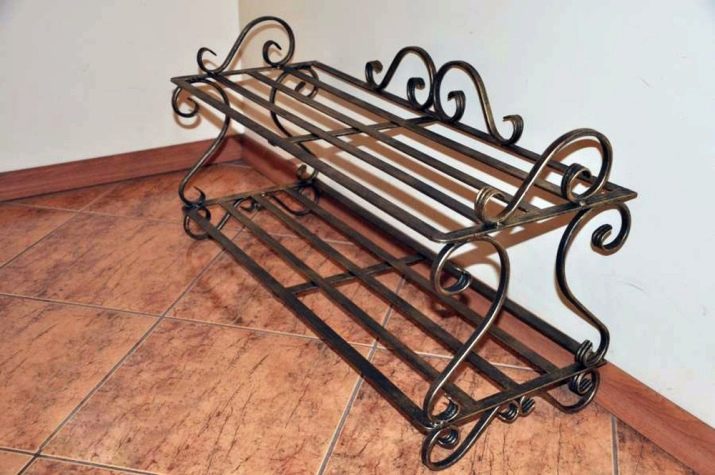
Vine and rattan
Natural and environmentally friendly material, is well washed and dried. Due to gaps in the weaving, air has access to the shoe, which allows it to be ventilated even in closed models. Often, baskets made from natural material are made from vines; they become an ideal place to store shoes. Rattan is used in eco and ethnic styles, in all types of country, whitened models are used in the theme of Provence and shabby chic. Artificial rattan refers mainly to the summer cottage option, it is used both indoors and outdoors.

Plastic
Plastic products are rarely used in apartments, they are more suitable for country halls. This modern lightweight material is not afraid of moisture, it is easy and quick to wash (especially smooth options). Today, the industry makes durable plastic in a variety of colors, imitating stone and wood. Plastic products do not fit well with wood, they can only be used in modern surroundings. Variegated options fit the style pop Art.

the cloth
Particularly durable material with a large proportion of synthetics, used in non-standard shoe racks. Sometimes such shoe racks are made to order for extraordinary interiors. The fabric is selected easily washable, often has a mesh base, which allows free circulation of air inside it.

The size
The parameters of the shoebox directly depend on the capabilities of the hallway. In a large room, you can install a wardrobe with shelves, or highlight the volume section in the headset. This will allow you to collect shoes in one place for all seasons and the whole family. This option makes it easier to review and care for it. You will not need to get shoes from secluded and not always accessible places with the onset of the next season.
Spacious hallways are often equipped with several types of shoe racks. In addition to an all-weather cabinet, they install a design on 2-3 shelves for everyday needs. The taste of the owner and the style of the room will tell you which option is better to stay. It can be sofas or benches with shelves for shoes. Small shoe racks are often equipped with hangers, supports for umbrellas, drawers for small items.


Medium-sized halls can solve the problem with either shoes for all seasons or outerwear (coats, jackets). For a small everyday shoe, hidden under a hanger, there is also a place in them.
Furniture developers do not ignore the small hallways. Shoe boxes are able to occupy corners, thin niches, hang on doors and walls in the form of decor. Systems such as "slim" can install shoes at different angles, up to 90 degrees, which makes it possible to reduce the design depth to 13 cm. Miniature portable racks hold the shoes on their hinges in an upright position. Compact devices for boots look like a stand with loops that hold the shafts.


As you can see, the parameters of shoe racks can satisfy a hallway of any size. Shelves are able to contain shoes in a horizontal position, at any angle and standing, the depth of the product depends on this.
Cabinets
This is the most dimensional type of shoe racks, their standard depth (50-55 cm) provides horizontal storage, which gives a natural uniform load on the shoes, in this position it is better preserved for a long time. The height of the cabinet depends on the amount of shoes needed for the family.
Selecting the depth of the product, the scale of the hallway is taken into account. The smaller it is, the narrower the cabinet and the greater the angle of inclination for shoe shelves. Even tiny rooms can accommodate a narrow cabinet under the ceiling with a depth of not more than 20 cm. It will look like a panel on the wall, which will allow not to compress the space. Narrow tall cabinets have poor stability, so they are attached to the wall.

Pedestals
The size of the cabinet depends on the model. If it is with a bench or sofa, its height will not exceed 40-60 cm. The product can be open or closed, have 1-2 shelves for shoes and have a depth of 20 to 40 cm, which will allow it to take a place even in the smallest hallway . Curbstones are made with one or more seats, which also affects the parameters of the product.
The second version of the pedestals is used as a shoe rack and a table where you can put bags and then easily change shoes. Their height is 60-80 cm. Products resembling chests of drawers can reach 120 cm in height, their depth depends on the angle of the shelves.


Rotating racks
They are produced open and closed. The volume of the racks also depends on the angle of the shelves. Such products can have a height of 80-100-120 cm or rush to the ceiling. A rack with horizontally standing shoes is suitable for large hallways, as it takes about a meter in diameter and looks bulky.
Portable racks are similar in appearance to oil heaters. They are easily rearranged to any part of the hallway. Shoes are placed upright on the holders.


Color and design
If you have to purchase a shoe rack in an already equipped hallway, you need to try to achieve its match of color and texture with the environment. MDF, particleboard are presented on the furniture market with a large variety of colors. Such shoe racks need not imitate wood or stone. Coatings of various shades will suit modern interiors.
The entrance hall is the darkest room in the house, but if you install white furniture there, it will seem light and festive. White color requires constant care, but compensates for its dazzling beauty. A shoe rack can be strict and solemn at the same time, if you frame light surfaces with a black frame. Wood species such as alder and wenge will create a wood contrast.

Bright colors are suitable for children's shoes and pop art style. Halftones - cream, olive, mint, lavender, cream are used in the directions of shabby chic and provence. In addition to pastel colors, bleached aged wood is used to make furniture of these styles.

How to choose?
Going to buy shoes, you should clearly know what we want from her. Depending on the task, it can be:
- low, designed for 1-2 people, for everyday use (simple model in several shelves);
- wide, long, comprehensive - for the whole family and all seasons (wardrobe, bookcase with baskets);
- imperceptible, but functional (narrow mounted model);
- compact, with a bench, a mirror and a hanger (small, in the form of a bench or sofa in an integrated version);
- for a large collection of shoes (rotating stand);
- only under boots as an additional shoe rack (shoemaker);
- a small portable shoe rack for fans to often change the interior (a rack with vertical filling).

When the issue is resolved with functionality, you need to choose a place in the hallway for a new shoe rack. Everyday products should be at the front door, and any wall or corner is suitable for storing shoes while waiting for the season.
When a place is determined, it is measured to verify data with the product.
When purchasing a shoe rack, you need to pay attention to the interior of the hallway and choose a model in accordance with the harmony of the environment. For example, a Scandinavian-style shoe rack may look like a bookcase or light shelves with boxes. Shoe furniture in a room with a Gothic design is often chosen with forging elements. Metal products are suitable for high-tech, loft. A rough bench with a shelf for shoes will decorate a hallway in a rustic or chalet style. A beautiful symmetrical wooden product designed for classic hallways.

When sizes, functionality and style are defined, you can pay attention to the manufacturer and the quality of the goods, and if everything is in order with them, a long service shoe will be provided.
Use in different styles
It is not easy to create a stylized interior in a small corridor, but for a large room this task is quite feasible. The final touch in the design can be a shoe rack that matches the style of a particular hallway. A large selection of designs is presented on the furniture market, where you can pick up a model of any stylistic direction. As an example, consider shoe racks designed for various design tasks.
- Shoe storage design in style loftmade from water pipes.


- Hallway made in colonial style. The shoe rack is combined with a hanger and a tiny sofa.


- Wooden chest of drawers decorated with gilding and ornament. Suitable for directions Baroque, Rococo, Empire.



- In style country often used bench with soft pillows, which contains wicker baskets for shoes.

- White hallway towards high tech simple and concise. A small shoe rack does not overload a space filled with air and light.

- Shoe rack with bench and style hanger provence made of natural wood. The technique of aging wood is used.


- The beech model with the slim system is endowed with additional drawers for small items and made for classic interiors. The compact design allows its use in small hallways.


- Simple modern shoe racks are used in a fairly young direction of interiors - Contemporary.

- Cupboard for shoes with wicker boxes, made in scandinavian style.


- Shoe rack in vintage style imitates suitcases stacked on top of each other.


- Hallway towards avant-garde with a narrow hanging shoe rack.


- English classic style in the hall. The cabinet for shoes, combined with a mirror, is endowed with a box for small items.

- Elephant-shaped shoe bench designed for African interiors.

- Simple but elegant shoe in the hallway style grunge. The model with open shelves supports the lightness and airiness of the room.

Good examples
Every day, returning home, we take off our shoes, and the place in which we put them can disrupt the harmony of the hallway or support it, it all depends on the appearance of the shoe and its functionality. Modern products surprise with variety, using all kinds of materials, colors and styles in their designs. Extraordinary models are sometimes found that easily adapt to any situation. This can be seen by considering the following examples.
- In the hallway in the Provence style, several types of shoe racks are used, one of them is quite ordinary, wooden, and the second resembles a chrome hanger, which is used for shoes.

- The storage location of the shoe is a sheet of metal, curved by the wave. The design is compact, almost does not take up space in the hallway, designed for shoes and slippers. Meets the demands of modern techno-styles.

- The design consists of two modules, by rebuilding of which the shoe rack can change its appearance every day.

- Retractable shelves with horizontally mounted shoes.


- Small shoe rack with shelves located at an angle. To open it, you just need to pull the handle down.


- The shoe storage on the wall is so minimal that it can be mistaken for minimalist decor.

- An example of a ceiling pillar with a rotation element.


- Homsu stand with vertical installation. It is very compact, easily rearranged to any place, and can accommodate about 20 pairs of shoes.

- The loft-style design can hardly be attributed to convenient models, but it safely fits with a dozen sneakers of the same size.


- Stylish closet in the hallway with a large compartment for shoes.


- An extraordinary shoe stand made of metal and fabric.


- A simple shoe rack for boots.
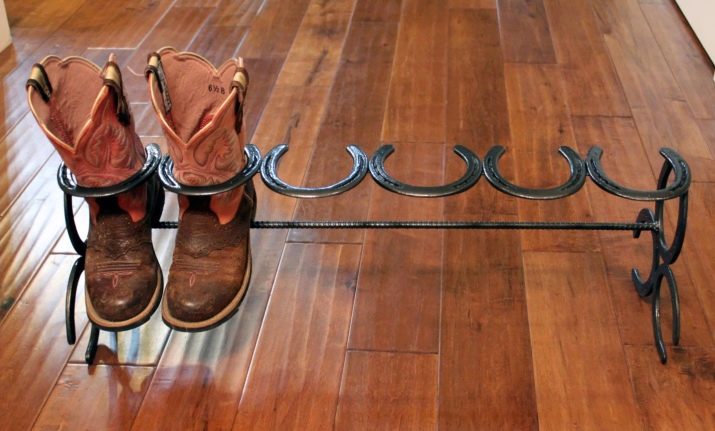
- Shoe storage areas are located in a decorative column that adorns the interior and at the same time fulfills its practical tasks.

- An unusual version of the bench.

- The stand is very beautiful, made under a bent tree, but so intricate that you do not immediately understand how shoes should get into it.


- Shoemaker.


- The corners in the hallway can be occupied by shoe racks created specifically for this purpose.

A properly planned entrance hall should not only look spectacular, but also be convenient. Having crossed the threshold of the apartment, I want to put my bags somewhere, sit down on something, take off and hide my shoes, hang up my coat and look in the mirror.
Choosing a shoe rack, you can purchase everything else in a complex, with one purchase you can create comfort in the entire hallway.
Watch a workshop on making shoes in the video below.










